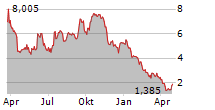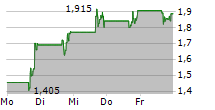
Enhanced protection of vision with ANX007 treatment in healthier eyes
Greater preservation of EZ in the central fovea by ANX007 in patients with less advanced GA
Pivotal Phase 3 ARCHER II Data Expected Second Half 2026
BRISBANE, Calif., Oct. 21, 2024 (GLOBE NEWSWIRE) -- Annexon, Inc. (Nasdaq: ANNX), a biopharmaceutical company focused on upstream C1q to advance therapies for neuroinflammatory diseases of the body, brain and eye, today announced new findings from its Phase 2 ARCHER study for ANX007 in geographic atrophy (GA) due to dry age-related macular degeneration (AMD). ANX007 demonstrated enhanced protection of vision and greater preservation of central photoreceptor cells in a subpopulation of patients with less advanced disease as measured by the photoreceptor ellipsoid zone (EZ) in the central fovea. The data were presented at the American Academy of Ophthalmology (AAO) 2024 annual meeting. ANX007 is a first-in-kind, non-pegylated antigen-binding fragment (Fab) designed to block C1q locally in the eye with an intravitreal formulation.
"Photoreceptors near the foveal center are necessary for high acuity vision like reading an eye chart or seeing faces. Protecting these cells is essential to preserving vision and we are encouraged by ANX007's consistent and robust effect on this structural element of the eye," said Douglas Love, president and chief executive officer of Annexon. "We are further encouraged by ANX007's more pronounced treatment effect on both preservation of vision and photoreceptors in patients with less advanced disease. Importantly, these Phase 2 data highlight the potential of ANX007 to deliver a differentiated benefit, particularly with earlier intervention in a neurodegenerative disease, and we are encouraged by the promise ANX007 holds to help millions of patients worldwide with dry AMD and GA."
As previously described, in the randomized Phase 2 ARCHER trial, ANX007 demonstrated a visual function benefit consistently across multiple measures that was both dose and time dependent. This includes significant broad-based protection of vision in standard and low light conditions and significant protection of photoreceptors in the fovea region critical for visual acuity. These Phase 2 data are further reinforced in a subpopulation of patients with less advanced disease defined by low light visual acuity (LLVA) < 30 at baseline and in patients with more intact vision as defined by <80% EZ loss.
Key highlights of the new data presented at AAO include:
- Protection from vision loss observed in patients with less advanced disease vs. overall patients through month 12
- 0% (0/56) ANX007 monthly-treated patients with less advanced disease lost 15 letters, or three lines on an eye chart, vs. 17% (10/59) sham patients (Nominal p-value 0.0013)
- 6% (5/89) ANX007 monthly-treated overall patients lost 15 letters vs. 21% (19/89) sham overall patients (Nominal p-value 0.0021)
- ANX007 enhanced protection against EZ loss in central subdomains in patients with more EZ intact at baseline
- 61% decrease in EZ loss between ANX007 and sham in patients with < 80% EZ loss at baseline (Nominal p-value 0.0575)
- 48% decrease in EZ loss between ANX007 and sham in patients with < 98% EZ loss at baseline (Nominal p-value 0.0218)
About ANX007 and Phase 2 ARCHER Trial
ANX007 is an antigen-binding fragment (Fab) antibody designed as a first-in-kind therapeutic to selectively inhibit C1q, the initiating molecule of the classical complement pathway and a key driver of neurodegeneration. In dry age-related macular degeneration (AMD) or geographic atrophy (GA), C1q binds to photoreceptor synapses, causing aberrant activation of the classical pathway with synapse loss, inflammation and neuronal damage that results in vision loss. Intravitreal administration of ANX007 fully stopped C1q and classical pathway activation. In animal models, the murine analog of ANX007 protected against loss of photoreceptor synapses and cells to preserve function. ANX007 has been granted Fast Track designation from the Food and Drug Administration and is the first therapeutic candidate for the treatment of GA to receive Priority Medicine (PRIME) designation in the EU, which provides early and proactive support to developers of promising medicines that may offer a major therapeutic advantage over existing treatments or benefit to patients without treatment options.
In the randomized, multi-center, double-masked, sham-controlled Phase 2 ARCHER clinical trial, ANX007 demonstrated consistent protection against vision loss across multiple measures in a broad population of patients with GA. ANX007 provided statistically significant, time and dose-dependent protection from vision loss as measured by = 15 letter loss on reading an eye chart with best corrected visual acuity (BCVA=15), the widely accepted and clinically-meaningful functional endpoint. Significant protection from vision loss was also shown in other prespecified measures of BCVA and visual function, including low luminance visual acuity (LLVA) and low luminance visual deficit (LLVD). ANX007's treatment effect increased over the course of the on-treatment portion of the study, suggesting that ANX007 may provide a growing and durable treatment effect over time. While benefit gained against vision loss was maintained during the subsequent six-month off-treatment period, the rate of decline for BCVA = 15-letter vision after treatment termination began to parallel that of sham, providing additional support for the observed on-treatment protection. ANX007 was also shown to protect key retinal structures important for vision, including significant protection of photoreceptors as measured by optical coherence tomography (OCT) and supported by slowing of loss of retinal pigment epithelial cells (RPE) near the fovea, as measured by fundus autofluorescence (FAF). ANX007 was generally well-tolerated through month 12, with no increase in choroidal neovascularization (CNV) rates between the treated and sham arms and no events of retinal vasculitis reported.
About Dry AMD and Geographic Atrophy
Dry age-related macular degeneration (AMD) is the most common form of AMD and geographic atrophy (GA) is an advanced form of dry AMD, an eye disease that is the leading cause of blindness in the elderly. Dry AMD and GA are chronic progressive neurodegenerative disorders of the retina involving the loss of photoreceptor synapses and cells in the outer retina. GA affects an estimated one million people in the United States and eight million people globally, severely limiting their independence and causing frustration, anxiety and emotional hardship. Effective treatments that preserve vision are still needed, as no currently approved therapies have been shown in clinical trials to significantly prevent vision loss.
About Annexon
Annexon Biosciences (Nasdaq: ANNX) is harnessing neuroinflammation to advance potentially first-in-kind treatments for millions of people living with serious neuroinflammatory diseases of the body, brain and eye. Our novel scientific approach focuses on C1q, the initiating molecule of a potent inflammatory pathway that when misdirected can lead to tissue damage and loss. By targeting C1q, our immunotherapies are designed to stop neuroinflammatory diseases where they start. Our pipeline spans three diverse therapeutic areas - neurodegenerative, ophthalmic and autoimmune diseases - and includes investigational drug candidates designed to address the unmet needs of over 8 million people worldwide. Annexon's mission is to deliver potentially game-changing therapies to patients so that they can live their best lives. When they thrive, we thrive. To learn more visit annexonbio.com.
Forward Looking Statements
This press release contains forward-looking statements within the meaning of Section 27A of the Securities Act of 1933, as amended, and Section 21E of the Securities Exchange Act of 1934, as amended. In some cases, you can identify forward-looking statements by terminology such as "aim," "anticipate," "assume," "believe," "contemplate," "continue," "could," "design," "due," "estimate," "expect," "goal," "intend," "may," "objective," "plan," "positioned," "potential," "predict," "seek," "should," "suggest," "target," "on track," "will," "would" and other similar expressions that are predictions of or indicate future events and future trends, or the negative of these terms or other comparable terminology. All statements other than statements of historical facts contained in this press release are forward-looking statements. These forward-looking statements include, but are not limited to, the ability of ANX007 to block upstream C1q, the clinical and regulatory status of ANX007; ANX007's distinct potential neuroprotective mechanism of action and potential to provide protection from vision loss; the potential therapeutic benefit of ANX007; Annexon's ability to stop neuroinflammatory diseases where they start; and Annexon's ability to deliver game-changing therapies to millions of patients. Forward-looking statements are not guarantees of future performance and are subject to risks and uncertainties that could cause actual results and events to differ materially from those anticipated, including, but not limited to, risks and uncertainties related to: the ongoing off-treatment follow-up portion of the Phase 2 ARCHER trial; the company's history of net operating losses; the company's ability to obtain necessary capital to fund its clinical programs; the early stages of clinical development of the company's product candidates; the effects of public health crises on the company's clinical programs and business operations; the company's ability to obtain regulatory approval of and successfully commercialize its product candidates; any undesirable side effects or other properties of the company's product candidates; the company's reliance on third-party suppliers and manufacturers; the outcomes of any future collaboration agreements; and the company's ability to adequately maintain intellectual property rights for its product candidates. These and other risks are described in greater detail under the section titled "Risk Factors" contained in the company's Annual Report on Form 10-K and Quarterly Reports on Form 10-Q and the company's other filings with the SEC. Any forward-looking statements that the company makes in this press release are made pursuant to the Private Securities Litigation Reform Act of 1995, as amended, and speak only as of the date of this press release. Except as required by law, the company undertakes no obligation to publicly update any forward-looking statements, whether as a result of new information, future events or otherwise.
Investor Contact:
Joyce Allaire
LifeSci Advisors, LLC
jallaire@lifesciadvisors.com
Media Contact:
Sheryl Seapy
Real Chemistry
949-903-4750
sseapy@realchemistry.com




